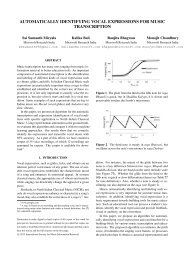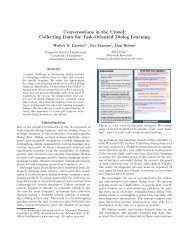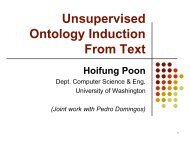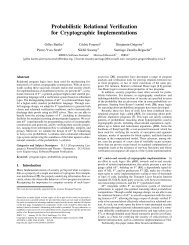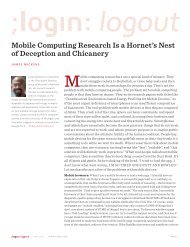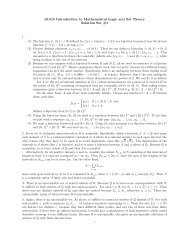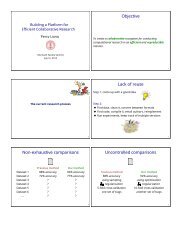Hierarchical Probabilistic Segmentation of Discrete Events
Hierarchical Probabilistic Segmentation of Discrete Events
Hierarchical Probabilistic Segmentation of Discrete Events
You also want an ePaper? Increase the reach of your titles
YUMPU automatically turns print PDFs into web optimized ePapers that Google loves.
2009 Ninth IEEE International Conference on Data Mining<br />
<strong>Hierarchical</strong> <strong>Probabilistic</strong> <strong>Segmentation</strong> Of <strong>Discrete</strong> <strong>Events</strong><br />
Guy Shani<br />
Information Systems Engineeering<br />
Ben-Gurion University<br />
Beer-Sheva, Israel<br />
shanigu@bgu.ac.il<br />
Christopher Meek and Asela Gunawardana<br />
Machine Learning and Applied Statistics<br />
Micros<strong>of</strong>t Research<br />
Redmond, USA<br />
{meek/aselag}@micros<strong>of</strong>t.com<br />
Abstract—<strong>Segmentation</strong>, the task <strong>of</strong> splitting a long sequence<br />
<strong>of</strong> discrete symbols into chunks, can provide important information<br />
about the nature <strong>of</strong> the sequence that is understandable<br />
to humans. Algorithms for segmenting mostly belong to the<br />
supervised learning family, where a labeled corpus is available<br />
to the algorithm in the learning phase. We are interested,<br />
however, in the unsupervised scenario, where the algorithm<br />
never sees examples <strong>of</strong> successful segmentation, but still needs<br />
to discover meaningful segments.<br />
In this paper we present an unsupervised learning algorithm<br />
for segmenting sequences <strong>of</strong> symbols or categorical events.<br />
Our algorithm, <strong>Hierarchical</strong> Multigram, hierarchically builds<br />
a lexicon <strong>of</strong> segments and computes a maximum likelihood<br />
segmentation given the current lexicon. Thus, our algorithm<br />
is most appropriate to hierarchical sequences, where smaller<br />
segments are grouped into larger segments. Our probabilistic<br />
approach also allows us to suggest conditional entropy as a<br />
measurement <strong>of</strong> the quality <strong>of</strong> a segmentation in the absence<br />
<strong>of</strong> labeled data.<br />
We compare our algorithm to two previous approaches<br />
from the unsupervised segmentation literature, showing it to<br />
provide superior segmentation over a number <strong>of</strong> benchmarks.<br />
We also compare our algorithm to previous approaches over<br />
a segmentation <strong>of</strong> the unlabeled interactions <strong>of</strong> a web service<br />
and its client.<br />
I. INTRODUCTION<br />
In a number <strong>of</strong> areas data is naturally expressed as a long<br />
sequence <strong>of</strong> discrete symbols or events. Typically, humans<br />
find it difficult to identify patterns or chunks within the long<br />
sequence. In such cases it may be beneficial to automatically<br />
segment the sequence into smaller chunks, resulting in a<br />
shorter sequence over a higher level lexicon [1], [2].<br />
For example, many modern s<strong>of</strong>tware applications maintain<br />
logs <strong>of</strong> events that occur during the execution. Such<br />
logs are useful for understanding the behavior <strong>of</strong> the deployed<br />
application under real conditions and for analyzing<br />
traces <strong>of</strong> failures. Typically these logs are very large and<br />
understanding the behavior by looking at the sequence <strong>of</strong><br />
recorded events becomes very difficult. However, if we can<br />
automatically identify that certain subsequences (or chunks)<br />
<strong>of</strong> these sequences originate from certain procedures, replacing<br />
these chunks by a single procedure name can make<br />
understanding these logs more manageable.<br />
We are interested in two specific types <strong>of</strong> scenarios.<br />
The first scenario is the analysis <strong>of</strong> web service usage;<br />
web services are s<strong>of</strong>tware applications that provide services<br />
for s<strong>of</strong>tware clients. In this application, the web service<br />
are instrumented to maintain a log <strong>of</strong> the client requests.<br />
Analyzing these logs can shed light on the behavior <strong>of</strong> the<br />
client applications, allowing us to better optimize the server<br />
responses. The second type <strong>of</strong> scenario is the analysis <strong>of</strong><br />
user-driven s<strong>of</strong>tware applications. Examples <strong>of</strong> such applications<br />
are word processors and spreadsheets. In this scenario,<br />
the s<strong>of</strong>tware is instrumented to capture sequences <strong>of</strong> user<br />
actions. Understanding these sequences <strong>of</strong> actions can (e.g.)<br />
help us to construct better user interfaces. In both these<br />
examples we do not have access to the high level process —<br />
the human user or the client application — that generated<br />
the sequences, and therefore we do not know the high level<br />
task and subtasks.<br />
In our <strong>Hierarchical</strong> Multigram approach to segmentation<br />
we consider the segmentation task as having two sub-tasks:<br />
(i) lexicon identification in which we identify meaningful<br />
segments, or chunks and (ii) sequence segmentation in which<br />
the sequence is segmented given a current lexicon. In the<br />
<strong>Hierarchical</strong> Multigram approach developed in this paper,<br />
we iteratively interleave these two tasks. Given a lexicon,<br />
we segment the sequences. We use the new segmentation to<br />
identify a new lexicon by selectively concatinating chunks.<br />
We continue this process until we have a hierarcy <strong>of</strong> chunks.<br />
We then choose between alternative segmentations (i.e.,<br />
the level <strong>of</strong> the hierarchy) by using the likelihood <strong>of</strong> the<br />
observed data.<br />
We compare the performance <strong>of</strong> our method to two<br />
previous algorithms, Sequitur [1] and Voting Experts [2],<br />
over standard benchmarks from the literature — an English<br />
and Chinese word identification tasks. In both cases our<br />
method outperform both Sequitur and Voting Experts.<br />
Finally, we present some results on lexicon acquisition<br />
and segmentation over a real data set <strong>of</strong> service requests<br />
from different clients accessing a Micros<strong>of</strong>t Exchange server.<br />
Even though we do not have labeled data for this domain, we<br />
show that our hierarchical lexicon acquisition method generates<br />
segments that capture much <strong>of</strong> the structure present<br />
in the logs. We measure this by estimating the Shannon<br />
entropy <strong>of</strong> the service request sequences that is captured<br />
by the segmentations generated by our algorithm.<br />
1550-4786/09 $26.00 © 2009 IEEE<br />
DOI 10.1109/ICDM.2009.87<br />
974<br />
Authorized licensed use limited to: MICROSOFT. Downloaded on January 13, 2010 at 16:43 from IEEE Xplore. Restrictions apply.
II. MOTIVATING EXAMPLES<br />
We begin by an overview <strong>of</strong> two motivating examples<br />
<strong>of</strong> real world domains where event sequences exist, but<br />
are currently analyzed only using statistics over the low<br />
level events. We explain for both domains why a better<br />
understanding <strong>of</strong> the high level process is needed.<br />
A. Micros<strong>of</strong>t Exchange Server<br />
The Micros<strong>of</strong>t Exchange Server is a messaging product,<br />
supporting e-mail, calendaring, contacts and tasks, and are<br />
accessed by many different s<strong>of</strong>tware clients. An Exchange<br />
server keeps a log <strong>of</strong> all the requests issued by the clients.<br />
These logs contain information such as user id, client<br />
application id and requested operation. We hence obtain<br />
sequences <strong>of</strong> operations corresponding to a single user<br />
interaction with a specific client application.<br />
These sequences contain only low level operations. A<br />
server administrator can use these low level operations to<br />
compute statistics, such as the frequency <strong>of</strong> an operation,<br />
or the average number <strong>of</strong> operations per session. Afterwards,<br />
these statistics can be used, for example, to execute<br />
simulation interactions with the server to test the server<br />
performance in extreme conditions.<br />
However, it was noticed by Exchange administrators that<br />
these simulations poorly imitate true user sessions. This<br />
is because in a true user session low level operations<br />
occur within the context <strong>of</strong> the high level process <strong>of</strong> the<br />
client application. Therefore, understanding the high level<br />
behavior <strong>of</strong> a client can improve these simulations, and allow<br />
Exchange administrators to better optimize server responses.<br />
B. User Interface Driven Applications<br />
In many cases user application, such as Micros<strong>of</strong>t Word<br />
or Excel, are instrumented to capture user behavior, such as<br />
clicks on toolbars or menus. These low level events can be<br />
later collected and sent to the application producer through<br />
tools such as Micros<strong>of</strong>t Customer Experience Improvement<br />
Program (CEIP) 1 . For example, when a Micros<strong>of</strong>t Office<br />
product experiences a failure, a user can allow a report to<br />
be sent back to Micros<strong>of</strong>t for analysis.<br />
Using these traces, s<strong>of</strong>tware engineers can reproduce<br />
problems locally, thus making it possible to better understand<br />
and fix the problem. However, Micros<strong>of</strong>t, like<br />
other producers <strong>of</strong> widely used s<strong>of</strong>tware, receive many such<br />
reports. Each report then needs to be transferred to a specific<br />
group that handles a specific failure. This classification<br />
process is very difficult when the only available data is<br />
statistics over the low level operations.<br />
Inferring the high level process that generated a trace can<br />
help both the classification process <strong>of</strong> reports, as well as the<br />
reproduction <strong>of</strong> problems in a controlled environment.<br />
1 http://www.micros<strong>of</strong>t.com/products/ceip/EN-US/default.mspx<br />
III. BACKGROUND AND PREVIOUS APPROACHES<br />
Let ⃗e =< e 0 , .., e n > be a sequence <strong>of</strong> discrete low level<br />
events where each e i belongs to a finite, known, alphabet<br />
Σ. Let η = {⃗e 0 , ..., ⃗e m } be a set <strong>of</strong> m such sequences.<br />
Let ⃗i be a segmentation <strong>of</strong> ⃗e — a sequence <strong>of</strong> indexes<br />
i 0 , ..., i k s.t. i 0 = 0, i k = |⃗e| + 1 and i j < i j+1 . We say<br />
that s is a segment in the sequence ⃗e with segmentation ⃗i if<br />
there exists j such that s = e ij , . . . , e ij+1−1. By extension,<br />
we say that s is a segment in η if there exists ⃗e ∈ η<br />
with segmentation ⃗i such that s is a segment in ⃗e with<br />
segmentation ⃗i. The set <strong>of</strong> all segments found in η will be<br />
called the lexicon, denoted by S.<br />
A lexicon S is hierarchical if for every s ∈ S containing<br />
more than a single event, there exist segments s 1 , .., s k ∈ S<br />
such that s = s 1 + ... + s k , where + is the concatenation<br />
operator. s 1 , ..., s k are the sub-segments <strong>of</strong> s.<br />
A natural application where such sequences arise is in<br />
the natural language research community, where chunks <strong>of</strong><br />
characters are concatenated into words, and word boundaries<br />
must be identified. Motivated by this domain, the Sequitur<br />
algorithm [1] builds a context free grammar — a set <strong>of</strong><br />
a rules <strong>of</strong> the form X i → X i1 , ..., X ik , where X ij is<br />
either a rule or a symbol. An expansion <strong>of</strong> a rule is the<br />
replacement <strong>of</strong> the left hand side <strong>of</strong> the rule with the right<br />
hand side repeatedly, until all rules have been replaced by<br />
symbols. These rules can be thought <strong>of</strong> as an hierarchical<br />
lexicon. Now, we can segment a sequence, by applying these<br />
rules such that each segment correspond to an expansion<br />
<strong>of</strong> a single rule. For example, we can decide that segment<br />
boundaries are placed after the expansion <strong>of</strong> rules <strong>of</strong> a fixed<br />
depth d.<br />
A second, probabilistic approach, is the Voting Experts<br />
algorithm suggested by Cohen et al [2], where a set <strong>of</strong><br />
independent criterions (experts) decide on segment boundaries.<br />
This algorithm uses a sliding window <strong>of</strong> a fixed length<br />
over the sequence. At each position <strong>of</strong> the window, each<br />
‘expert’ votes on the most likely segment boundary within<br />
the current window. Then, we traverse the sequence <strong>of</strong> votes,<br />
and introduce segment boundaries where the sum <strong>of</strong> votes<br />
for the next position is smaller than the sum <strong>of</strong> votes for the<br />
current position.<br />
Specifically, Cohen et al. use two experts — one that<br />
minimizes the internal entropy <strong>of</strong> the chunk, and one that<br />
maximizes the frequency <strong>of</strong> the chunk among chunks <strong>of</strong> the<br />
same length. Voting Experts was demonstrated to outperform<br />
Sequitur on a word boundary discovery from different<br />
languages, and in identifying robot motion sequences.<br />
IV. MULTIGRAM<br />
A multigram [3], [4] is a model originating from the<br />
language modeling community, designed to estimate the<br />
probabilities <strong>of</strong> sentences, given a lexicon <strong>of</strong> words. A<br />
sentence is modeled as a concatenation <strong>of</strong> independently<br />
drawn words. Here, we will model event sequences as<br />
975<br />
Authorized licensed use limited to: MICROSOFT. Downloaded on January 13, 2010 at 16:43 from IEEE Xplore. Restrictions apply.
“sentences” which are the concatenation <strong>of</strong> independently<br />
drawn segments (“words”). A multigram Θ defines a distribution<br />
over a lexicon <strong>of</strong> segments S = {s 1 , s 2 , ..., s m } as<br />
Θ = {θ i } : θ i = p(s i ).<br />
The likelihood <strong>of</strong> a sequence <strong>of</strong> segments ⃗s = s j1 , . . . , s jk<br />
where each s ji ∈ S is defined by ∏ i=1..k p(s j i<br />
) =<br />
∏<br />
i=1..k θ j i<br />
. The likelihood <strong>of</strong> all possible segment sequences<br />
{⃗s} consistent with a sequence <strong>of</strong> events ⃗e is<br />
computed by summing the probabilities <strong>of</strong> the different<br />
segment sequences.<br />
Given a lexicon and a sequence we can learn the segment<br />
probabilities using the a dynamic programming procedure<br />
derived by specializing the Forward Backward algorithm for<br />
HMMs [5] to the case <strong>of</strong> multigrams. We can use the model<br />
obtain a segmentation by using the Viterbi algorithm for<br />
HMMs.<br />
V. LEXICON ACQUISITION<br />
As we will later show in our experiments, the lexicon<br />
given to the multigram has a significant impact on the<br />
multigram accuracy. A lexicon can be defined by selecting<br />
a maximal length n and adding each sequence <strong>of</strong> length<br />
n or less that was observed in the data [4]. However, this<br />
approach can result in a huge lexicon, a long training time,<br />
and possible loss <strong>of</strong> accuracy due to local minima.<br />
It is therefore better to filter out some <strong>of</strong> the observed<br />
sequences using some function <strong>of</strong> the sequence probability<br />
such as its mutual information [6], as described below.<br />
A. <strong>Hierarchical</strong> Lexicon Acquisition<br />
We suggest here an iterative method for hierarchical lexicon<br />
acquisition. We begin with a lexicon containing all low<br />
level events (Σ), and the trivial single event segmentation.<br />
During each iteration we add concatenations <strong>of</strong> existing<br />
segments, where pairs <strong>of</strong> segments are chosen for concatenation<br />
using their mutual information. The mutual information<br />
<strong>of</strong> the concatenation xy <strong>of</strong> segments x and y is estimated<br />
by:<br />
I(x; y) = p(xy) log<br />
p(xy)<br />
(1)<br />
p(x)p(y)<br />
where probabilities are estimated over the observed data.<br />
For each concatenation whose mutual information exceeds<br />
a predefined threshold, we create a new segment, and add it<br />
to the lexicon. Then we train a multigram over the expanded<br />
lexicon, produce a new segmentation and a new iteration begins.<br />
If no sequence passes the mutual information threshold,<br />
the threshold is reduced.<br />
The process is stopped when the threshold is less than<br />
ɛ and we can then select the lexicon that maximized the<br />
likelihood <strong>of</strong> the data. As this lexicon is created by always<br />
joining together sequences <strong>of</strong> segments from the lexicon, it<br />
is hierarchical.<br />
When creating a new segment to augment the lexicon, we<br />
remember the segments that were concatenated to create it.<br />
We hence maintain for each segment s an ordered list <strong>of</strong><br />
segments L s = s 1 , ..., s k such that s = s 1 + ... + s k , and<br />
each s i is in the lexicon. Each segment can participate in<br />
the creation <strong>of</strong> many longer segments.<br />
Our implementation uses mutual information as the criterion<br />
for creating new words, but other measurements<br />
such as the conditional probability or the joint probability<br />
can also be used. The power <strong>of</strong> the method comes from<br />
collecting term frequencies from already segmented data.<br />
Term frequencies are thus more accurate than frequencies<br />
that were computed over the raw data.<br />
Consider for example the input string abcdbcdab, segmented<br />
into ab|cd|b|cd|ab. In the raw data, the term bc<br />
appears twice, while in the segmented data the term does<br />
not appear at all. The term bcd appears twice in the raw<br />
data but only once in the segmented data.<br />
Algorithm 1 <strong>Hierarchical</strong> Multigram Learning<br />
input η = {⃗e 0, ..., ⃗e m}<br />
input δ — MI threshold<br />
i ← 0<br />
η 1 ← η<br />
S 0 = Σ η<br />
while δ > ɛ do<br />
i ← i + 1<br />
S i ← S i−1<br />
for each consecutive pair <strong>of</strong> segments s 1, s 2 in η i do<br />
if MI(s 1s 2) > δ then<br />
Add s 1s 2 to S i<br />
end if<br />
end for<br />
Initialize a multigram M using S i<br />
Train M on η i<br />
η i+1 ← φ<br />
for j = 0 to m do<br />
Add the most likely segmentation <strong>of</strong> ⃗e j given M to η i+1<br />
end for<br />
δ ← δ 2<br />
end while<br />
output η i−1<br />
VI. EVALUATING UNSUPERVISED SEGMENTATION<br />
In this paper we focus on unsupervised segmentation <strong>of</strong><br />
discrete event sequences. The typical method for evaluating<br />
the quality <strong>of</strong> a segmentation is to use a labeled data set,<br />
such as a set <strong>of</strong> sequences that were already segmented<br />
by an expert, and see whether the unsupervised algorithm<br />
recovers those segments. Alternatively, an expert can observe<br />
the resulting segmentation <strong>of</strong> several algorithms and decide<br />
which algorithm produced the best segmentation.<br />
However, in many cases obtaining even a relatively small<br />
labeled data set, or manually analyzing the output <strong>of</strong> an<br />
algorithm, can be very expensive. In such cases, we cannot<br />
evaluate the accuracy <strong>of</strong> a segmentation algorithm with<br />
respect to a true segmentation. We therefore suggest in<br />
the lack <strong>of</strong> labeled data to evaluate how well does the<br />
976<br />
Authorized licensed use limited to: MICROSOFT. Downloaded on January 13, 2010 at 16:43 from IEEE Xplore. Restrictions apply.
segmentation algorithm capture the underlying statistical<br />
structure <strong>of</strong> the low level event sequences ⃗e.<br />
A natural candidate for estimating the captured structure<br />
is the mutual information I( ⃗ E; ⃗ I) which is an information<br />
theoretic measurement <strong>of</strong> how much information a segmentation<br />
⃗i provides about the event sequence ⃗e [7]. We<br />
suggest that a segmentation algorithm whose output contains<br />
as much information about the event sequence, and hence<br />
the highest mutual information with respect to the event<br />
sequence should be preferred among the candidate segmentations.<br />
We note that this mutual information between the<br />
event sequence and its segmentation should not be confused<br />
with the mutual information between adjacent segments that<br />
was used in constructing the hierarchical lexicon.<br />
The mutual information can be written as<br />
I( ⃗ E; ⃗ I) = H( ⃗ E) − H( ⃗ E| ⃗ I)<br />
where H( ⃗ E) is the entropy <strong>of</strong> the event sequence and<br />
H( ⃗ E| ⃗ I) is the entropy <strong>of</strong> the event sequence given the<br />
segmentation [7]. Since only the second term depends on<br />
the segmentation, choosing the segmentation algorithm with<br />
the highest mutual information is equivalent to choosing<br />
the one with the lowest conditional entropy. The per-event<br />
conditional entropy can be estimated as:<br />
p(⃗e|⃗i) =<br />
Ĥ( E| ⃗ I) ⃗ = − 1 ∑ log p(⃗e|⃗i(e))<br />
|η| |⃗e|<br />
⃗e∈η<br />
∏ p(e ij , ..., e ij+1 )<br />
∑<br />
w∈D,|w|=i j+1−i j<br />
p(w)<br />
(i j,i j+1)∈⃗i<br />
where p(w) is estimated probability <strong>of</strong> a word w in the<br />
lexicon D.<br />
In order to estimate the conditional entropy <strong>of</strong> a segmentation,<br />
we divide the set <strong>of</strong> event sequences into a train and<br />
test set. We train a multigram over the train set learn the<br />
lexicon probabilities, initializing the lexicon to the words<br />
(segments) that were observed in the segmentation. Then, we<br />
estimate the conditional entropy <strong>of</strong> the given segmentation<br />
on the test set. It is important that the conditional entropy<br />
be estimated on a test set distinct from the lexicon training<br />
set in order to measure how well a segmentation captures<br />
the underlying structure <strong>of</strong> the event sequences, rather than<br />
measuring how close a segmentation comes to memorizing<br />
the training event sequences.<br />
A. Datasets and Algorithms<br />
In this section we provide an empirical comparison <strong>of</strong><br />
three unsupervised algorithms for segmentation — our hierarchical<br />
multigram approach, Sequitur [1], and Voting Experts<br />
[2]. Our results demonstrate the superiority <strong>of</strong> the segmentation<br />
that we produce both over previous approaches.<br />
We experiment here with two types <strong>of</strong> datasets; Much<br />
research is dedicated to the identification <strong>of</strong> word boundaries<br />
(2)<br />
(3)<br />
in Chinese text [8]. While this is an important task, and was<br />
previously used to demonstrate segmentation algorithms [2],<br />
it is not truly an unsupervised task, as many pre-segmented<br />
datasets <strong>of</strong> this type are available. Still, results for datasets<br />
that were segmented by experts can shed much light on<br />
the power <strong>of</strong> various approaches. As such, we use Chinese<br />
and English text here mainly to provide information about<br />
the properties <strong>of</strong> the various unsupervised segmentation<br />
algorithms. For these datasets we can use the annotated<br />
dataset to compute precision-recall curves.<br />
A task that is more interesting for us is the segmentation<br />
<strong>of</strong> event sequences from an Exchange server. This is a real<br />
world task, for which there is no existing annotated dataset.<br />
Indeed, this is the type <strong>of</strong> task for which unsupervised<br />
algorithms are constructed. In evaluating the segmentation<br />
<strong>of</strong> Exchange events, we use the mutual information criteria<br />
defined above.<br />
B. Segmenting Text<br />
We begin by a traditional evaluation <strong>of</strong> the quality <strong>of</strong><br />
the segmentation produced by the algorithms on a presegmented<br />
data set, as done by most researchers. The resulting<br />
scores may be somewhat misleading, as a supervised<br />
algorithm that is trained on the segmented data set can produce<br />
much better results. Still, such an evaluation is useful<br />
in providing an understanding <strong>of</strong> the relative performance<br />
<strong>of</strong> the unsupervised algorithms.<br />
We evaluate the three algorithms over two tasks — the<br />
identification <strong>of</strong> word boundaries in English and in Chinese<br />
texts [9], [2], [8]. For the English text, we took the first<br />
10 chapters <strong>of</strong> “Moby Dick” 2 and transformed the text into<br />
unlabeled data by removing all the characters that are not<br />
letters (spaces, punctuation marks, etc.) and transformed all<br />
letters to lower case. For the Chinese text we used the labeled<br />
Academia Sinica corpus 3 .<br />
Each <strong>of</strong> the algorithms has a tunable parameter for the<br />
decision on segment boundaries. Voting Expert has a sliding<br />
window, whose length affects the segment boundary identification.<br />
Sequitur identifies a set <strong>of</strong> rules, and in order to<br />
generate a segmentation from these rules, we place word<br />
boundaries after expanding rules up to a finite depth, after<br />
which rules are expanded into words. Our lexicon creation<br />
procedure is affected by the threshold on the required mutual<br />
information for concatenating chunks. We evaluate each<br />
algorithm at various settings <strong>of</strong> its tunable parameter.<br />
In order to compare the accuracy <strong>of</strong> the algorithms at<br />
various settings <strong>of</strong> their tunable parameters, we employ<br />
precision-recall curves, which are a typical measurement<br />
for the success <strong>of</strong> a segmentation algorithm. When identifying<br />
segment (or word) boundaries we can either correctly<br />
identify a boundary (TP — true positive), fail to identify<br />
2 www.physics.rockefeller.edu/ ∼ siggia/projects/mobydick novel<br />
3 www.sighan.org/bake<strong>of</strong>f2003/bake<strong>of</strong>f instr.html<br />
977<br />
Authorized licensed use limited to: MICROSOFT. Downloaded on January 13, 2010 at 16:43 from IEEE Xplore. Restrictions apply.
a segment boundary (FN — false negative), or predict a<br />
boundary within a segment (FP — false positive). Precision<br />
is defined as the portion <strong>of</strong> true positives among the guessed<br />
#T P<br />
#T P +#F P<br />
boundaries — , while recall is the portion <strong>of</strong> true<br />
positives among all the segment boundaries —<br />
#T P<br />
#T P +#F N .<br />
There is a clear trade-<strong>of</strong>f between precision and recall. At the<br />
extreme we can predict no boundary, making no mistake and<br />
getting a precision <strong>of</strong> 1, but identifying no boundaries and<br />
getting a recall <strong>of</strong> 0. At the other extreme we can identify<br />
a boundary after each symbol, getting a recall <strong>of</strong> 1 but a<br />
relatively low precision.<br />
Figure 1 shows the precision recall curves resulting from<br />
tuning the parameters. As we can see, our method dominates<br />
the two other on both data sets. These tasks have some<br />
hierarchical structure. For example, we can identify chunks<br />
<strong>of</strong> English words that occur repeatedly, such as “th”, “ing”,<br />
and “tion”. Identifying these chunks early in the process can<br />
help us to construct the words afterwards.<br />
Figure 2. <strong>Hierarchical</strong> segmentation <strong>of</strong> the Moby Dick text. Showing the<br />
first two sentences (left side) and another random sentence (right side).<br />
Correctly identified words are annotated by a star.<br />
Figure 1.<br />
(a) Moby Dick (English text)<br />
(b) 1998-01-qiefen (Chinese text)<br />
Precision-Recall curves on the two word segmentation problems.<br />
Our metric for comparing performance <strong>of</strong> methods for<br />
segmentation over an unlabeled data set is conditional<br />
entropy. To validate that this metric correlates with our<br />
intuitive notion <strong>of</strong> segmentation we compute the conditional<br />
entropies <strong>of</strong> the three algorithms for the text segmentation<br />
problem. Table I shows the conditional entropies <strong>of</strong> our<br />
approach, and the Sequitur and Voting Experts algorithms on<br />
the English and Chinese word segmentation tasks. For each<br />
algorithm we picked the segmentation that provided the best<br />
F score, defined as F = 2·precision·recall<br />
precision+recall<br />
. We then trained<br />
a multigram using the lexicon derived by the segmentation<br />
on a train set (0.8 <strong>of</strong> the data) and computed the conditional<br />
entropy <strong>of</strong> the given segmentation over the test set (0.2 <strong>of</strong> the<br />
data). In addition, we also evaluated the conditional entropy<br />
<strong>of</strong> the true segmentation using the same procedure.<br />
Algorithm English Chinese<br />
True 1.56 5.73<br />
HM 2.01 6.01<br />
Voting Experts 3.38 6.87<br />
Sequitur 3.00 9.25<br />
Table I<br />
CONDITIONAL ENTROPY OF THE VARIOUS SEGMENTATIONS OF THE<br />
THREE ALGORITHMS AND THE TRUE SEGMENTATION ON THE TWO TEXT<br />
SEGMENTATION TASKS.<br />
Figure 2 shows some sample output from the hierarchical<br />
segmentations yielded by our algorithm on the Moby Dick<br />
task. The algorithm does find the correct word boundaries<br />
in most cases, and also finds higher level structures such as<br />
“more than” and “have been.”<br />
Looking at Table I, we see that the true segmentation gives<br />
the most information about the text. This provides evidence<br />
that the structure captured by words is highly useful. The<br />
true segmentation is followed by our approach, Sequitur,<br />
and then Voting Experts for the English text. On the Chinese<br />
text Voting Expert outperformed the Sequitur approach. This<br />
978<br />
Authorized licensed use limited to: MICROSOFT. Downloaded on January 13, 2010 at 16:43 from IEEE Xplore. Restrictions apply.
corresponds well with the precision-recall curves in Figure 1.<br />
The ability <strong>of</strong> Sequitur to achieve higher precision at the<br />
expanse <strong>of</strong> lower recall, resulted in a higher conditional<br />
entropy.<br />
Shannon estimated that English had an entropy <strong>of</strong> about<br />
2.3 bits per letter when only effects spanning 8 or fewer<br />
letters are considered, and on the order <strong>of</strong> a bit per letter<br />
when longer range effects spanning up to 100 letters are<br />
considered [10]. We estimate the conditional entropy given<br />
word segmentations but not taking into account long range<br />
effects. Thus, we would expect the conditional entropy to<br />
be lower than the entropy taking into account only short<br />
range effects, though perhaps not as low as the entropy given<br />
longer range effects. Our results using the true segmentations<br />
as well as our results using the hierarchical multigram are<br />
consistent with this expectation.<br />
C. Segmenting Exchange Sequences<br />
We now move to evaluating the performance <strong>of</strong> the three<br />
algorithms over event sequences gathered from a Micros<strong>of</strong>t<br />
Exchange server. We obtained logs from the interactions <strong>of</strong><br />
the server with 5 different clients. As we can see in Table II<br />
the properties <strong>of</strong> the clients differ significantly in terms <strong>of</strong><br />
the functionality that they require from the server (Σ) and<br />
the length <strong>of</strong> a single interaction.<br />
We segmented all the domains using Voting Experts and<br />
the hierarchical multigram algorithms, varying the tunable<br />
parameters. Note that the Sequitur algorithm failed provide<br />
results on these data sets. We report in Table III the conditional<br />
entropy <strong>of</strong> the best segmentation that was achieved<br />
by each algorithm.<br />
Client |Σ| Sessions Avg. Session Length<br />
AS 22 24,630 19.5<br />
ASOOF 21 17,833 17<br />
OWA 56 9,689 14.7<br />
Airsync 54 27,115 25.9<br />
Table II<br />
PROPERTIES OF THE EXCHANGE CLIENT APPLICATIONS.<br />
Client HM Voting Experts<br />
AS 0.11 0.66<br />
ASOOF 0.069 0.067<br />
OWA 0.42 1.22<br />
Airsync 0.48 1.36<br />
Table III<br />
COMPARING THE CONDITIONAL ENTROPY OF THE HIERARCHICAL<br />
MULTIGRAM AND THE VOTING EXPERTS OVER THE VARIOUS<br />
EXCHANGE CLIENT APPLICATIONS.<br />
The hierarchical multigram generated segmentations with<br />
considerably better conditional entropy in all domains, except<br />
for the ASOOF client, which is by far the simplest and<br />
most structured domain, as we can see from the very low<br />
conditional entropy <strong>of</strong> both segmentations.<br />
VII. CONCLUSIONS<br />
In this paper we proposed an hierarchical probabilistic<br />
segmentation method based on a multigram. Multigram<br />
performance is highly dependent on the input lexicon that<br />
is provided. We propose a method for iteratively building<br />
an hierarchical lexicon. Our method computes the criteria<br />
for joining segments based on the current segmentation <strong>of</strong><br />
the data. As such, the generated term frequencies are more<br />
accurate.<br />
We experimented with a text segmentation problem, showing<br />
our method to produce superior accuracy, and over real<br />
data sets gathered from an Exchange server, showing our<br />
method to provide models with lower conditional entropy<br />
than a previous algorithms.<br />
Our hierarchical segmentation results in a tree <strong>of</strong> segments.<br />
In the future we would investigate further properties<br />
<strong>of</strong> this tree, such as the best cut through the tree that would<br />
produce the best segmentation <strong>of</strong> the data. We also intend to<br />
apply our techniques to the segmentation <strong>of</strong> user interactions<br />
with applications, allowing us to understand the behavior <strong>of</strong><br />
users when accomplishing complicated tasks.<br />
REFERENCES<br />
[1] C. Nevill-Manning, , and I. Witten, “Identifying hierarchical<br />
structure in sequences: A linear-time algorithm,” Journal <strong>of</strong><br />
Artificial Intelligence Research, vol. 7, pp. 67–82, 1997.<br />
[2] P. Cohen, N. Adams, and B. Heeringa, “Voting experts: An<br />
unsupervised algorithm for segmenting sequences,” Intell.<br />
Data Anal., vol. 11, no. 6, pp. 607–625, 2007.<br />
[3] S. Deligne and F. Bimbot, “Language modeling by variable<br />
length sequences: Theoretical formulation and evaluation <strong>of</strong><br />
multigrams,” in Proc. ICASSP ’95, 1995, pp. 169–172.<br />
[4] ——, “Inference <strong>of</strong> variable-length linguistic and acoustic<br />
units by multigrams,” Speech Commun., vol. 23, no. 3, pp.<br />
223–241, 1997.<br />
[5] L. E. Baum, , T. Petrie, G. Soules, and N. Weiss, “A<br />
maximization technique occurring in the statistical analysis <strong>of</strong><br />
probabilistic functions <strong>of</strong> markov chains,” Ann. Math. Statist.,<br />
vol. 41, no. 1, pp. 164–171, 1970.<br />
[6] M. Yamamoto and K. Church, “Using suffix arrays to compute<br />
term frequency and document frequency for all substrings<br />
in a corpus,” Computational Linguistics, vol. 27, no. 1,<br />
pp. 1–30, 2001.<br />
[7] T. M. Cover and J. A. Thomas, Elements <strong>of</strong> information<br />
theory. John Wiley and Sons, Inc., 1991.<br />
[8] R. Sproat and T. Emerson, “The first international chinese<br />
word segmentation bake<strong>of</strong>f,” in The Second SIGHAN Workshop<br />
on Chinese Language Processing, 2003.<br />
[9] H. J. Bussemaker, H. Li, and E. D. Siggia, “Regulatory<br />
element detection using a probabilistic segmentation model,”<br />
in ISMB, 2000, pp. 67–74.<br />
[10] C. E. Shannon, “Prediction and entropy <strong>of</strong> printed english.”<br />
The Bell System Technical Journal, pp. 50–64, January 1951.<br />
979<br />
Authorized licensed use limited to: MICROSOFT. Downloaded on January 13, 2010 at 16:43 from IEEE Xplore. Restrictions apply.



